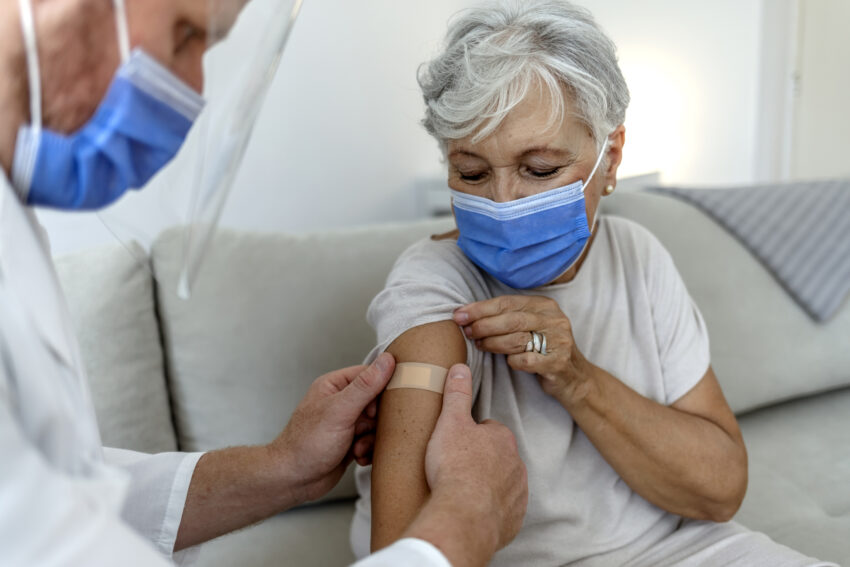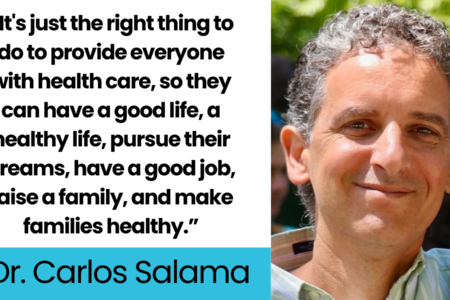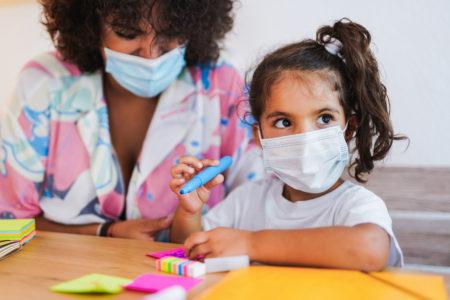
Share On Social!
The CDC recently announced updated COVID-19 vaccination recommendations.
The update allows people ages 65 and older or immunocompromised to get an additional updated bivalent vaccine dose at least four months after their initial bivalent dose.
“If you’re in this group and have questions about getting an additional COVID-19 vaccine dose, you should consult your healthcare provider,” according to Public Health Communications Collaborative.
Read more about the updated vaccine recommendations and why they matter for Latinos.
The Updated COVID-19 Vaccine Recommendations
Other changes made by the CDC’s Advisory Committee on Immunization Practices include:
- Monovalent (original) mRNA COVID-19 vaccines will no longer be recommended for use in the United States.
- CDC recommends that everyone ages 6 and older receive an updated (bivalent) mRNA COVID-19 vaccine, regardless of whether they previously completed their (monovalent) primary series.
- Individuals ages 6 and older who have already received an updated mRNA vaccine do not need to take any action unless they are 65 years or older or immunocompromised.
- For young children, multiple doses continue to be recommended and will vary by age, vaccine, and which vaccines were previously received.
“CDC and ACIP will continue to monitor COVID-19 disease levels and vaccine effectiveness in the months ahead and look forward to additional discussion around potential updates this fall,” according to the CDC.
Learn about all CDC COVID-19 vaccine recommendations here.
Why Was There an Update?
Having an additional dose of the updated vaccine would give this group extra protection from getting seriously ill with COVID-19.
“Older adults and people with compromised immune systems are at higher risk for severe COVID-19, and data show that the effectiveness of COVID-19 vaccines wanes over time,” according to the Public Health Communications Collaborative.
The CDC reports that alternatives to mRNA COVID-19 vaccines remain available for people who cannot or will not receive an mRNA vaccine.
The CDC’s recommendations for use of (monovalent) Novavax or Johnson & Johnson’s Janssen COVID-19 vaccines were not affected by the changes.
Latinos, COVID-19, and Vaccines
As of March of 2023, only 36% of Latinos are fully vaccinated and boosted, a lower percentage than their White (50%) and Black (49%) peers.

Another 35% of Latinos are fully vaccinated with no boosters, 3% are partially vaccinated and 26% are unvaccinated – a percentage nearly the same as their White and Black peers.
Vaccines are important because of the disproportionate impact of COVID-19 on Latinos.
“Black and Hispanic adults report higher levels of financial impacts and worry about illness than their White counterparts when it comes to COVID-19 related issues, reflecting the increased burden the pandemic has placed on people of color over the past two years,” according to KFF.
The Biden administration ended the national emergency and public health declarations related to the COVID-19 pandemic on May 11, 2023.
First put into place in 202 by the Trump administration, the declarations allowed for the federal government the flexibility to waive or modify certain requirements in a range of areas, like Medicare, Medicaid, CHIP programs, and in private health insurance.
A complete list of what the end of the declarations entail and what it means can be found here.
The KFF reports that Hispanic adults (33%) and those with lower incomes report possible negative impacts for their families as public health emergency ends.
Helping Latinos Against COVID-19
Looking to receive a vaccination or booster?
Find a location near you in English or Spanish!
Are you or someone you know still hesitant about getting vaccinated?
Learn more about Rosa Herrera and what changed her heart and pushed her to get the vaccine along with others that switched from vaccine hesitancy to confidence.
Explore uplifting stories about Latinos that became “change of heart” heroes! Read in English or Spanish.
Share these stories with others!
By The Numbers
142
Percent
Expected rise in Latino cancer cases in coming years




[…] The pandemic is another chapter in the bitter story of American racism and inequality. Black and Latinx people are being infected and are dying at much higher rates than white Americans. Many people of […]
[…] coronavirus has killed over 61,000 Latinos in America according to the CDC, accounting for over 18.2% of the total COVID deaths in the […]
[…] Whereas Hispanics make up 11% of D.C.’s inhabitants, they signify 19% of the COVID cases, and 14% of the deaths. Equally, 46% of D.C.’s residents are Black, they usually make up an alarming 75% […]
[…] and historical mistreatment. According to the U.S. Centers for Disease Control and Prevention, Latino and Black American communities are three times more likely to become infected with […]
[…] Covid pandemic has hit the Latino community particularly hard, and data from the nonprofit health equity advocacy group Salud America! shows Latinos lead in the 0-24 age […]
[…] the pandemic, Latinos took major blows, both in terms of COVID-19 cases and also from the economic recession under former President Donald Trump. Nearly half (49%) of […]
[…] the positive trend, the harm may have already been done. The pandemic has disproportionately impacted Latino communities. Reuters reported that election-related or political disinformation that […]
[…] pesar de la tendencia positiva, es posible que el daño ya esté hecho. La pandemia ha impactado desproporcionadamente Comunidades latinas. Reuters informó que la desinformación política o relacionada con las […]
[…] residentes blancos muestran una tasa mucho más baja con 10 muertes por cada 100,000 habitantes(8 9) . Los afroestadounidenses por su parte, denuncian subsistemas de salud que les segregan […]
[…] https://salud-america.org/coronavirus-case-rates-and-death-rates-for-latinos-in-the-united-states/ […]
[…] https://salud-america.org/coronavirus-case-rates-and-death-rates-for-latinos-in-the-united-states/ […]
[…] communities have the second-highest number of COVID-19 cases in the U.S. They’re also more likely to become hospitalized and die from the disease than other […]
[…] total, around 160,000 Latinos were killed by COVID-19. This accounts for 16% of the 1 million deaths in the country. The […]